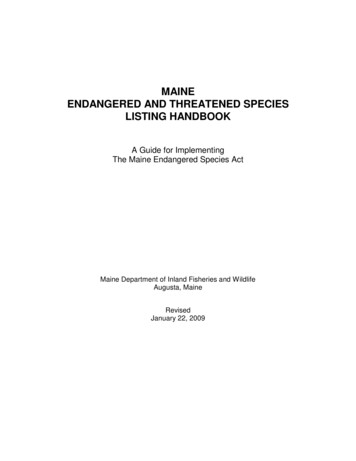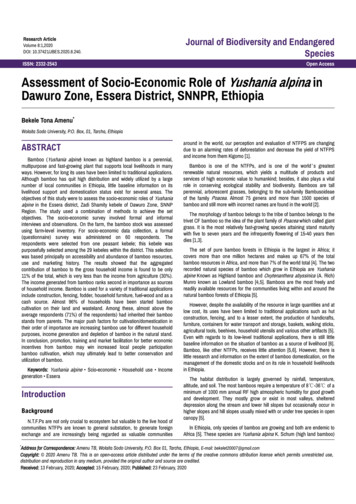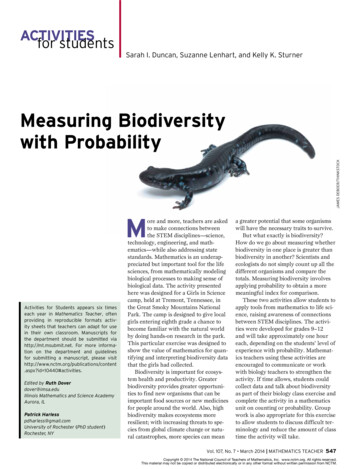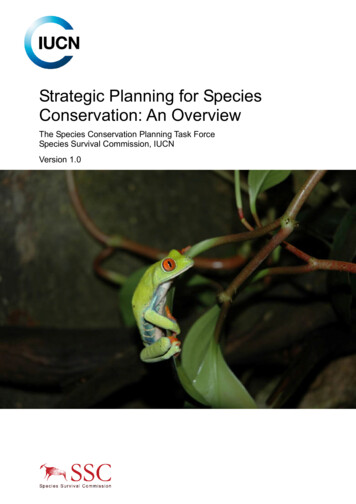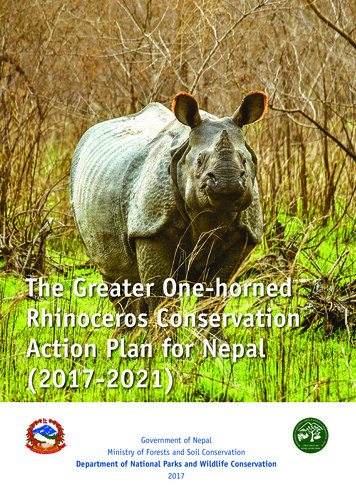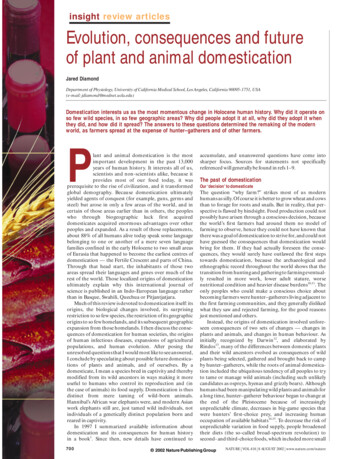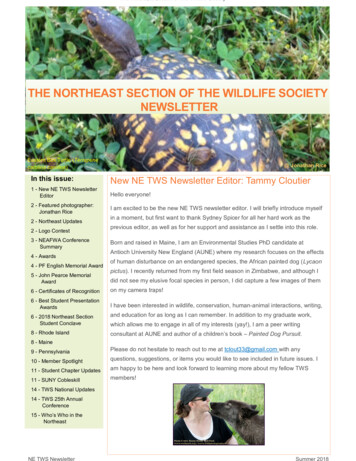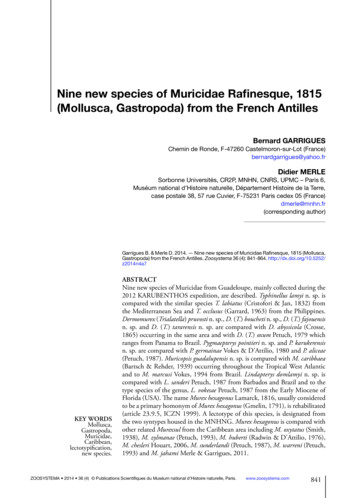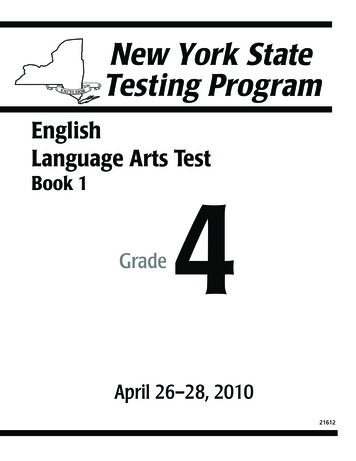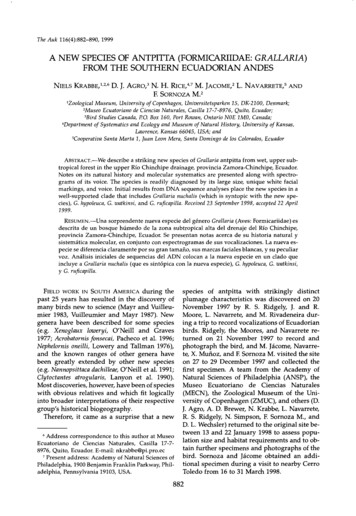
Transcription
The Auk 116(4):882-890, 1999A NEW SPECIESOF ANTPITTA (FORMICARIIDAE: E,TM D. J. AGRO,3 N.H. RICE,4'7M. JACOME,2 L. NAVARRETE,5 ANDE SORNOZA M? ZoologicalMuseum,Universityof Copenhagen,Universitetsparken15, DK-2100,Denmark;2MuseoEcuatorianode CienciasNaturales,Casilla 17-7-8976, Quito, Ecuador;3Bird Studies Canada, P.O. Box 160, Port Rowan, Ontario NOE 1MO, Canada;4Departmentof versityofKansas,Lawrence,Kansas66045, USA; andsCooperativaSantaMarta 1, JuanLeonMera, cribea strikingnew speciesof Grailariaantpittafrom wet, uppersub-tropicalforestin hipe,EcuadorNoteson its naturalhistoryand molecularsystematicsare presentedalongwith spectrogramsof its voice.The speciesis readilydiagnosedby its largesize,uniquewhite facialmarkings,andvoice.Initial resultsfromDNA sequenceanalysesplacethenewspeciesin awell-supportedcladethat includesGrailarianuchalis(whichis syntopicwith the new species),G. hypoleuca,G. watkinsi,and G. ruficapilla.Received23 September1998,accepted22 April1999.RESUMEN.--Unasorprendentenuevaespeciedel g6neroGrailaria(Aves:Formicariidae)esdescritade un bosquehfimedode la zonasubtropicalalta del drenajedel Rio ntannotasacercade su historianaturalysistemfiticamolecular,en conjuntoconespectrogramasde susvocalizaciones.La nuevaespeciesediferenciaclaramentepor su grantamafio,susmarcasfacialesblancas,y supeculiarvoz. Anfilisisinicialesde sequenciasdel ADN colocana la nuevaespecieen un cladoqueincluyea Grailarianuchalis(quees sint6picaconla nuevaespecie),G. hypoleuca,G. watkinsi,y G. ruficapilla.FIELDWORKIN SOUTHAMERICAduring the speciesof antpitta with strikingly distinctpast25 yearshasresultedin the discoveryof plumagecharacteristicswas discoveredon 20many birds new to science(Mayr and Vuilleu- November 1997 by R. S. Ridgely, J. and R.mier 1983, Vuilleumier and Mayr 1987). NewMoore, L. Navarrete, and M. Rivadeneira dur-generahave been describedfor somespecies ing a trip to recordvocalizationsof Ecuadorian(e.g. Xenoglauxloweryi,O'Neill and Graves birds. Ridgely,the Moores,and Navarretere1977;Acrobatornisfonsecai,Pachecoet al. 1996; turned on 21 November 1997 to record andNephelornisoneilli,Lowery and Tallman 1976), photographthe bird, and M. Jicome,Navarreand the known rangesof other generahave te, X. Mufioz, and F. Sornoza M. visited the sitebeen greatly extendedby other new species on 27 to 29 December 1997 and collected the(e.g.Nannopsittacadachilleae,O'Neill et al. 1991; first specimen.A team from the AcademyofClytoctantesatrogularis,Lanyon et al. 1990). Natural Sciencesof Philadelphia(ANSP), thede f species Museo Ecuatorianowith obviousrelativesand which fit logically (MECN), the ZoologicalMuseumof the Uniinto broaderinterpretationsof theirrespective versityof Copenhagen(ZMUC), andothers(D.group'shistoricalbiogeography.J. Agro, A.D. Brewer,N. Krabbe,L. Navarrete,Therefore,it cameas a surprisethat a new R. S. Ridgely,N. Simpson,E SornozaM., andD. L. Wechsler)retumed to the original sitebetween 13 and 22 January1998 to assesspopu6Addresscorrespondenceto this authorat Museolationsize and habitatrequirementsand to obEcuatoriano de Ciencias Naturales, Casilla 17-7tain furtherspecimensandphotographsof the8976,Quito, ademyof Natural Sciencesofbird. Sornoza and Jicome obtained an - tional specimenduring a visit to nearbyCerroToledo from 16 to 31 March 1998.adelphia,Pennsylvania19103,USA.882
October1999]NewAntpittafromEcuador883FIG.1. Headof is magnificationof cheekfeather.Drawing by S. Trammell.arablefrom known antpittasby white cheekpatch of rigid hesubocularandposteriorpart of the lowerloresto the baseofthebill (seeFig. 1).Thewhitecheekpatchcontrastssharplywith theblackcap,bill malarreGrailaria ridgelyi sp. nov.gion,and anteriorauricularfeathers.The newJocotocoAntpittaspeciesdiffersfrom all otherGrailariain lackHolotype.--MECNNo. 7199,adult male(skull ing true rictalbristles.The throatfeathersareFive specimensof the new bird were collected and comparedwith specimensof otherformicariids.Theyclearlyrepresenta new taxonthat we proposeto name:ossified,no bursa of Fabricius),collected28 December1997by E SornozaM. (FS 1922)in Que-white, stiff, and loose-barbed,as in the Ochre-stripedAntpitta (G.dignissima),but are denser,bradaHonda,provinciaZamora-Chinchipe,Ec- shorter,and with more recurvedtips, as inuador (04ø29'S, 79ø08'W; elevation 2,520 m). Chestnut-napedAntpitta (G. nuchalis).TheVocalrecordingsarearchivedat theLibraryof gray of the underpartsis interspersedwithNatural Sounds(LNS 79055).A blood sample white in a pattern resemblingpale-bellied(FS-1-28.12.97)is depositedat the Institutefor membersof the G. agenUniversity The bill is shapedmostlike that of G. nuchalis(IPE); tissue samplesare deposited as ANSP andthe onatelydeeperat the baseand with aDiagnosis.--Alarge antpitta (body mass150 straighterculmen.Tarsiand toesproportionto 200g) assignableto the genusGrailaria.Sep- atelylargerthanin otherantpittasandaslarge
884KRABBEETAL.[Auk, Vol. 116as in Giant Antpitta (G.gigantea).Tarsalscutes brown, and the tarsi and toes are blue-gray.few and distinctlyridgedwith toesand clawsshortand sturdy,resemblingG. nuchalis.Descriptionof holotype.--Crown,a 1 to 2-mmwide featheredocularring, broadmalars,andanteriorauricularsconnectingwith malarsJetBlack (capitalized color names and numbersfollow Smithe1975).A large and distinctfanshaped patch of rigid, loose-barbedwhitefeatherswith glossyshaftsin theloralandsubocularregion(seeFig. 1). Thesefeathersarelongerand denserthan in congenersand coverThe stomach contained a few insect remains,and someof the remiges,rectrices,and bodyfeatherswere beingreplaced.Measurementsof holotype.--Unflattenedwingchord130 mm, flattenedwing chord138 mm,tail 59.6 mm, bill from anterioredgeof nostril19.3 mm, bill from skull 33.5 mm, gonys18.8mm, tarsus67.1 mm, body mass176 g (lightfat), testes12 x 3 min.Designationof paratypes.--Adultmale: ANSP187810(skin);Natural History Museumat Unithe base of the bill and most of the malar reversityof Kansas(KU) 89207(trunk alcoholicgion. Rictal bristleslacking,but a few of the specimen);ANSP 8706(tissue);KU 2214 (tissuewhite loral feathershaveelongatedbareshafts,' subsampleand genomicextract);LNS 79054formingbristle-likeextensions.Poorlydefined (voice). Adult male: MECN 7284 (skin); IPEpostocularstreak,posteriorpart of auriculars, FS1-31.3.98(blood).Adult female:MECN 7198andsidesof neckLightNeutralGray(85).Nape (skin); ANSP 8704 (tissue). Adult female:black but suffused with color of back, which is ANSP 187811(skinwith all bonesexceptthoseclosestto BrownishOlive (129),but moregold- of right tarsometatarsusand footremoved;i.e.en.Uppermantlewith blackwashthatdecreas- a "schmoo");KU 89206(skeleton);ANSP 8731es posteriorly.All backfeatherswith blackish (tissue);KU 2215 (tissuesubsampleand genoshafts.Tail, composedof 12 rectrices,between mic extract);IPE NK1-21.1.98(blood).Raw Umber (223)and Mars Brown(223A).TheMECN 7284 was taken on the eastslopeofthree innermost secondaries and outer webs ofCerroToledo(2,680m) 6 km northof the typethenineothersecondariesslightlylighterthan locality,just within PodocarpusNationalPark,Chestnut(32). The distalhalf of the outerwebs on 31 March 1998.The remainingthree paraof the 10 primaries are Ground Cinnamon typesweretakennearthe type localityin Jan(239),the innerwebsof the remigesareblack- uary 1998 at 2,550 m.ish, and the underwing primary covertsareVariationin ngcovertsBrownishOl- than females,althoughthe sexesoverlapinive with 2-mm wide blackish shaft streaks andmeasurementsof areborderedby a belly is white in two malesand white lightly1-mm wide blackish band. Alula Brownish Olsuffusedwith LightNeutralGrayin thetwo feive like back,outerwebsnearlyuniform. Breast males and the third male (MECN 7284). TheWhite with light suffusionof Light Neutral amount of buff on the crissum is variable andGray. Throat white, featherswith fairly stiff, is strongestin two of the males,fainterin theglossy,elongatedand recurvedshaftsthat on other male (ANSP 187810) and one femalesome chin feathersare faintly dark-tipped. (ANSP 187811),and absentin the otherfemale.Feathersof upper breastwith faint, blackish, Thefaintbarson theupperbreastaremostdisabout l-ram wide terminal suffusions. Crissumtinctiveon theholotypeand MECN 7284.Theand extreme lower belly washed with Pale amount of black suffusion on the mantle is leastPinkishBuff (121D).Sidesof breastBrownish extensivein sLightNeutralGraysuf- existsin the intensityof the grayon thebreast.fusedwith BrownishOlive.ThighsBrownish Amongtheparatypesthebill isjet black,withOlive admixedwith Light Neutral Gray and the tip of the mandiblegrayishin one femaleheavilywashedwith black.Undertailcoverts (ANSP 187811).Other soft-part colorswereand underwingcovertsBrownishOlive, with (ANSP 187810 [male] and MECN 7198 [fefineblackbars.A singlecompletelyblackfeath- male]):iridesKingfisherRufous(240),tarsiander is on the left shoulder,a nearlyblackoneon toes Pratt'sPayne'sGray (88) with blackishthe right thigh, and most of the olive-brown joints and edgesof scutes,nails Dark Neutralfeathershavefaintblackishtips.In life,thebill Gray (83); ANSP 187811 (female): mouthis jet black, the irides are crimsonreddish creamywhite tinged pink, irides Mahogany
October1999]NewAntpittafromEcuador885TABLE1. Measurementsof Grailariaridgelyisp.nov.Valuesareœ SDofthreemalesandtwofemales(rangein parentheses).VariableMalesFemalesBody mass(g)Exposedculmen(mm)Bill from skull (mm)Bill from nostril (mm)192 14.3 (176 to 204)28.2 1.0 (27.1 to 29.0)34.8 1.63 (33.5 to 36.6)19.5 0.85 (18.9 to 20.5)167 21.2 (152 to 182)27.8 1.1 (27.0 to 28.5)33.0 - 0.14 (32.9 to 33.1)18.4 0.35 (18.1 to 18.6)Bill width at base(mm)Gonys(mm)16.1 1.01(15 to 17)19.8 1.27 (18.8to 21.2)16.0 0.28(15.8to 16.2)18.9 0.14 (18.8to 19.0)Unflattenedwingchord(mm)131 3.61(128to 135)126- 2.83(124to 128)Flattenedwing chord(mm)138 2.52(135to 140)132 1.41(131to 133)Tail (mm)Tarsus(mm)Middle toe (mm)Hind claw (mm)58 2.43 (55 to 66)71.1 3.59 (67.1 to 74.1)47.1 1.91 (46.0 to 49.3)13.9 0.25 (13.6 to 14.1)54 4.81 (50 to 57)70.4 - 4.24 (67.4 to 73.4)45.4 (n 1)13.6 0.57 (13.2 to 14.0)Red (132B), tarsi Plumbeous Gray (87-88);MECN 7284 (male): irides maroon,feet bluishgray.transcriptionof the Spanish"Jocotoco"(pronounced"hocot6co"),a localonomatopoeiaforthe antpitta.MECN 7284: testes 13 X 5 mm, seminal ves-iclesenlarged;ANSP 187810:testes5 X 2 mm;MECN 7198: ovary 11 X 6 mm, largest ovum1.8 mm; ANSP 187811:ovary 15 X 3 mm, largest ovum 2 mm, oviduct convoluted.Distribution.--Knownfroma smallarea ofREMARKSPopulation.--Thatsucha l 1997suggeststhat G. ridgelyihas a very limited geo-very wet forestin the upper Rio Chinchipe graphicdistributionand/or e,south- quirements.At the type locality,we estimatedern Ecuador, where it has been recorded at el- six territoriesof G. ridgelyiper squarekm andevationsranging from 2,300 to 2,680 tivematerial.--We examined all to the southeastand southwest.Accordingly,knownspeciesof Grailariawith theexceptionof we speculatethat it occursthroughoutthesethe TachiraAntpitta (G. chthonia),for whicha forests,rangingeastand southeastto Cordisuitabledescriptionis available(specimensin llera de Tzunantza and the southernpart ofMECN, ANSP,and LouisianaStateUniversity Cordillera del Condor, and southwest to theMuseum of Natural Science[LSUMNS]).Rio Isimanchi.Weconsiderit possiblethat,deEtymology.--Wearepleasedto namethisspe- spiteprevioussurveysthat failedto detecttheandRahciesin honorof RobertS. Ridgely.Duringhis species(Parkeret al. 1985,Rasmussenfield work in South America over the last 35bek 1994),G. ridgelyialsorangesfarthersouthyears,and duringhis manyyearsat the Acad- westto CerroChinguela,Peru,andthroughoutemy of Natural Sciencesof Philadelphia,Bob the PodocarpusNationalParknorth to Rio Zahasgathereda vastknowledgeof Neotropical mora.Its rangemightevenexceedtheselimits,birds. His combination of field and museum exand we encouragesearchesfor it as far northperienceandthoroughacquaintancewith Neo- and south as Volc n Sumaco in northern Ectropicalornithologicalliteratureis outstand- uador and the centralAndesof Peru,respecing. He hassharedhisknowledgewith a wide tively.audience and stimulated an interest in NeoHabitat.--Thefive specimenswere collectedtropicalbirdsthroughhisbooksA Guideto the in wet montaneforestwith two or morespeciesBirds of Panama(Ridgely and Gwynne 1976) of bambooon steepslopesin the upper suband TheBirdsofSouthAmerica(RidgelyandTu- tropicalzone.The highestelevationat whichdor 1989,1994).It is fittingthat the discovery the birds were found (2,680m) coincideswithof thisastoundingnewantpittacomesaswork the upperlimit of Cecropiatrees,whichare awith his coauthorPaulJ.Greenfieldon yet an- much-usedindicatorof the upperlimit of theother landmark book, The Birdsof Ecuador, subtropicalzone (Ulloa and Joergensen1993).nearscompletion.TheEnglishnameis a direct Tree height rarely exceeded20 m on steep
886KRABBEETAL.[Auk,Vol. 116slopes,with mosttreesabout10 m tall. Most threwtheirheadsbackin typicalantpittafashtrunks, stems, and branches were covered in ion. Theyusuallyrespondedin closepairs,asthicklayersof dripping-wetmoss,lichens,and do severalothermembersof thefamily,notablyliverworts. During our 12 field days we fre- someGrallariculaand Grailarianuchalis(Fjelds and Krabbe e five stomachs contained "a fewVocalizations.--Thesongof G. ridgelyi(Fig.2A), whichwasonly observedgivenby males, insect remains," "worms and beetles," "ants,"consistsof a seriesof 6 to 10 or more notes(400 "beetle parts and larvae,. arthropod reto 650Hz) separatedby intervalsof 1 to 2 s, dis- mains," and "millipede and insectremains."tinctly lowerpitchedthan songsof its closest All stomachcontentshavebeen depositedatrelatives(Fig. 2D). The qualityof the notesis ANSP for future identificationof specificpreyreminiscentof thoseof Pteroptochostapaculos items.and the Rufous-bandedOwl (Strix albitarsis), Breeding.--Nospecimen had greatly enandalland at a distancethe notesmay be confused largedgonads,all hadlight fat reserves,with a barkingdog.Followingplayback,notes but one,a heavilywornJanuaryfemale,wereinweregivenfor aslongas90 s;thepitchandam- generalmolt (presumablyprebasic);this sugplitude (volume)rose slowlyfor more than 1 geststhat breedingoccursat leastin Octobermin,with notesdeliveredevery0.6s;thepitch and November, which is consistent with thethen leveledand the pacebecameslowerand breeding cycle of congenersin this region(pers.obs.,M. B. Robbinspers. comm.).Howmore dog-like.The call (Fig. 2B), givenby both sexes,is a ever,despitebeingin molt and havingfairlysofter, two-noted "ho-co." Notes are about 575 smalltestes,the Marchspecimenhad well-deand475Hz, with the secondnoteoccasionally velopedseminalvesicles.higherpitched.Weheardthe call givensingly,or repeatedlyevery 4 to 10 s, with intervalsSYSTEMATICSshortestafterplayback.The alarm (Fig. 2C), given after repeatedThe taxonomicaffinitiesof the new speciesplayback,is similarto thecall but thelastpart werestudiedthroughphylogeneticanalysisofis a churred "h6-crrr" or "ho-c6-crrr."mitochondrialDNA by N.H. Rice.Songsand callsgenerallyweregivenat dawnTaxa examined.--Elevenspeciesof Grailariaandduskbut alsoat othertimesof dayduring antpittaswere studied,includingtwo individrain and in mistyweather Birdsvocalizedcon- ualsof thenewspecies(Table2). Previousworksiderably more in November and December (N. Riceunpubl.data)suggestedthat Grallarithan in January,whennaturalsongwasheard cula,Hylopezus,and Myrmotheraform a sisteron only a few occasions.In late March, we lineageto erplaybacks.genera form a well-supportedmonophyleticBehavior.--Thespecieshas only been ob- group. Accordingly, single representativesservedafter respondingto playbackof songs from Grallaricula,Hylopezus,and Myrmotheraand calls.Most individuals (four pairs and one were chosenas outgroupsfor characterpolarsolitary bird) approachedconsiderablyless ization(Table2). Freshlyfrozenor ethanol-precautiouslythanmostotherspeciesof Grailaria, servedtissues(liver, heart, and muscle)withand they were often heard moving through associatedvoucherspecimenswere obtainedvegetationor occasionallyon the forestfloor from LSUMNS and eneticresults.--Thecytochrome-bandrelatively aggressive,sometimescoming to ND2 matricesproduced congruenttree topolwithin4 or 5 m of theobserverTheymovedac- ogieswith comparablesupportregardlessoftivelyfrombranchto branch,or ran alonghor- anches2 to 4 m abovetheground(less thetopologyresultingfromthecombinedanaloftenon theforestfloor),periodicallystopping ysis is discussedin detail.to sing. a,Hylopezus,andMyrmotheraidly bobbedtheir headsto below the level of as outgroups,and with equal weightingastheir perch.Singingbirds pumpedtheir tails signed to transitions and transversions,a sindown in synchronywith each "hoot" and gle most-parsimonioustree resulted (TL
ii1020Time ( )FIG.2. (A) Songof G. ridgelyi(LNS88163;recordedby L. Navarrete).(B)Male callof G.ridgelyi(recordedby D. Agra). (C) Excitedmale call of G. ridgelyiafter repeatedplaybackof song(recordedby D. Agra). (D)Left to right, songsof G. ridgelyi(seeFig. 2A), G. carrikeri(La Libertad,Peru;recordedby T. A. Parker),G.nuchalis(Napa, Ecuador;recordedby N. Krabbe),G. watkinsi,and G. ruficapilla(Laja, Ecuador;recordedbyN. Krabbe),respectively.1,261, CI 0.548, HI 0.452, RI 0.518; Fig. (1) large antpittasof the subgenusGrailariaby3). This hypothesissupportsmonophylyof (LoweryandO'Neill dGrailaria.Within Grailaria,it recognizestwo G.squamigera,well-supportedand stronglyresolvedclades: (2) antpittasreferredto the subgeneraTham-
888KRABBEETAL.[Auk, Vol. 116TABLE2. Taxaandtissuesamplesusedin thisstudy,with GenBankaccessionnumbersof thederivedDNAsequences.GenBank numberTaxonTissue no.ND2CytochromebGrailariasquamigeraLSUMNS 6254AF127203AF127188G. variaLSUMNSAF127204AF127189G.guatimalensisG. 127190G. blakeiLSUMNSAF127207AF127191G. ruficapillaANSP 4906AF127208AF127192G. watkinsiG. nuchalisANSP 2906ANSP 4905AF127209AF127212AF127193AF127197G. ridgelyi1G. ridgelyi2G. hypoleucaG. onsMyrmotheracampanisonaANSP 8706ANSP 8731ANSP 4476ANSP3229ANSP 3744ANSP4039LSUMNS AF127200AF12720175285620nocharis,Hypsibemon,and Oropezusby LoweryandO'Neill (1969),althoughthisdivisionisnotsupported.The cladehasthe G. rufulacomplex(G. rufulaand G. blakei)asits basallineage,andamongthe other speciesan unexpectedsisterspeciesrelationshipbetweenG. watkinsiare sistertaxaand surprisingly,they form thesisterlineageto a clade containingG. ridgelyiHypothesisinterpretationand implications.The new speciesis strongly supported as amember of the Grailariaclade (97% bootstrapvalue) and, within the limits of our taxonsam-and G. muchalis.chalis, also is a member of the clade that con-pling,asthesisterto G.nuchalis(82%bootstrapsupport).From this relationship,we infer thatG. carrikeri,for which no biochemical materialis available,but which Schulenbergand Williams (1982) suggestedis a relative of G. nu-Gralla#asquamigera01O0 97G. guatimalensisG. rufu/a12597G.vat a7l G.b/akei1O0G.ru capilla8021 82998967 5 500G.ridgelyi4 33G. n'dgelyiG.nucha/is( G.hypo/eucaG.dignissirna-- Grallat npanisonaF G.3. Cladogramrepresentingthe singlemost-parsimonioustreebasedon trapvaluesfor eft) and numberof unreversedsynapomorphies(right) for eachclade.
October1999]NewAntpittafrornEcuadortains G. ridgelyiand G. tingthisrelationship(carrikeri nuchalis ridgelyi)arethat all haveunpatternedbreasts,smokygrayflanks,anda deep,robustbill. Consistentwiththis is their biogeography:all three have helaboratoryportionof thisstudywasprovidedby a FrankM. ChapmangrantfromtheAmerican Museumof Natural History to NHR. N. Simp-son generouslysponsoredthe establishmentof"Fundaci6nJocotoco"andthe purchaseof the typelocality.innorthern Peru, Ecuador, and Colombia. Inter-LITERATURE CITEDestingly,G.carrikeriandG.ridgelyihavedistinct FJELDS,g,,J.,ANDN. KRABBE.1990.Birdsof theHighblackcapsandreddishirides.Andes. ZoologicalMuseum,Universityof Copenhagen,Copenhagen,Denmark.CONSERVATIONLANYON, S. M., D. E STOTZ,AND D. E. WILLARD. 1990.Clytoctantesatrogularis,a new speciesof antbirdfrom lyiis oneof a numberof species580.with very restrictedrangesalongthe middle LOWERY,G. H., ANDJ.P. O'NEILL.1969.A new speRio Marafi6n,and assuchit is potentiallyvulciesof antpittafromPeruand a revisionof thenerable to habitat alteration and other unnatural disturbances. Hence, 700 ha of forest sur-subfamilyGrallariinae.Auk 86:1-12.LOWERY,G. H., ANDD. A. TALLMAN.1976.A new genusand speciesof nine-primariedoscineof un-rounding the type locality of G. ridgelyiwascertain affinities from Peru. Auk 93:415-428.purchasedin October1998and turnedinto a1983.New speciesofreservelargeenoughto hold a viablepopula- MAYR,E., ANDE VUILLEUMIER.birds described from 1966 to 1975. Journal ftirtion of the antpitta.The reserveis ownedandOrnithologie124:217-232.managedby "Fundaci6nJocotoco,"a nonprofit1977.A new genusorganizationfoundedwith thepurposeof pre- O'NEILL,J.E, ANDG. R. GRAVES.andspeciesofowl(Aves: trigidae)from Peru.servingand promotingthe study of globallyAuk 94:409-416.endangeredbird speciesthroughpurchaseand O'NEILL, J.P., C. A. MUNN, AND I. FRANKE. 1991.managementof land in Ecuador.GrailariaridgeNannopsittacadachilleae,a new speciesof parrotlyi also occurson neighboringland in thelet from eastern Peru. Auk 108:225-229.southernendof PodocarpusNationalPark,un- PACHECO,J. E, B. M. WHITNEY, AND L. P. GONZAGA.derscoringthe importanceof the park,which1996. A new genusand speciesof furnariidalready holds severalknown threatenedand(Aves:Furnariidae)fromthe Rahgionof southeasternBahia,Brazil.WilsonBulletin 108:397-433.bek 1994),in preservingthe diversityof AnPARKER,t. A. III, T. S. SCHULENBERG,G. R. GRAVES,dean avifauna.AND M. J. BRAUN.1985. The avifauna of theACKNOWLEDGMENTSWe thank M. thernPeru.Pages169197in Neotropicalornithology(P.A. Buckley,M.S. Foster,E. S. Morton, R. S. Ridgely, and E G.Buckley,Eds.).OrnithologicalMonographsNo.36.de Agriculturay Ganaderla)for help in obtainingJ. E, AND C. RAHBEK.1994. Aves delcollectingandexportpermits;A.D. Brewer,J.andR. .Moore, X. Mufioz, R. S. Ridgely,M. Rivadeneira,N.C.E.C.I.A., Quito, EcuadorSimpson,and D. L. Wechslerfor companionshipinR. S., ANDJ.A. GWYNNE,JR.1976.A guidethe field; M. Rivadeneira and X. Mufioz of Neblina RIDGELY,to the birds of Panama.PrincetonUniversityForestfor ablyhandlingthecomplexlogisticsof ourPress,Princeton, New Jersey.field sfor useof theircomputer;andM. B.Rob- RIDGELY,R. S., AND G. TUDOR.1989. The birds ofSouthAmerica,vol. I. Universityof TexasPress,bins, L. Joseph,A.D. Navarro-Sigtienza,and D. E.Austin.Willard for valuableguidanceand usefulcommentsRIDeELY,R. S., AND G. TUDOR.1994. The Birds ofon early draftsof the manuscript.FinancialsupportSouthAmerica,vol. II. Universityof TexasPress,for our expeditionswasprovidedby J.and R. MooreAustin.and N. Simpson.Curatorsat ANSP (R. S. Ridgely)t. S., AND M.D. WILLIAMS. 1982. Aand LSUMNS(E H. Sheldon)generouslymadefro- SCHULENBERG,zen tissues available for research. S. Trammell ofnewspeciesof antpitta(Grailaria)fromnorthernPeru. Wilson Bulletin 94:105-113.ANSP drew the sketchfor Figure 1. Financialsupano de CienciasNaturales) and S. Lasso(Ministerio
890KRABBEETAL.SMITHE,E B. 1975.Naturalist'scolorguide.AmericanMuseumof Natural History,New York.ULLOA,C., AND?. M. JOERGENSEN.1993.Arbolesyarbustos de los Andes del EcuadorInstituteVUILLEUMIER,E, ANDE. MAYR.1987.New speciesofbirds described from 1976 to 1980. Journal arhusUniversity,Aarhus,Denmark.[Auk, Vol. 116Associate Editor: R. M. Zink
4Department of Systematics and Ecology and Museum of Natural History, University of Kansas, Lawrence, Kansas 66045, USA; and sCooperativa Santa Marta 1, Juan Leon Mera, Santa Domingo de los Colorados, Ecuador ABSTRACT.--We describe a striki
